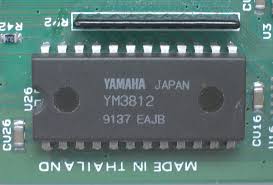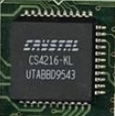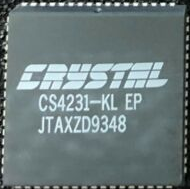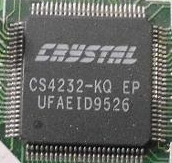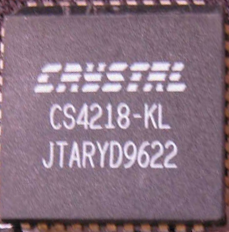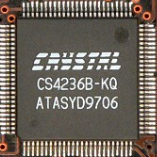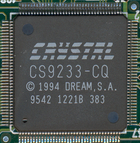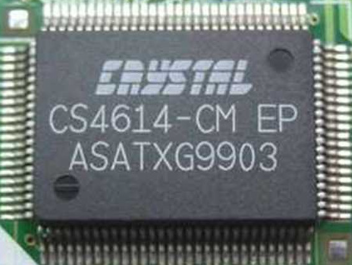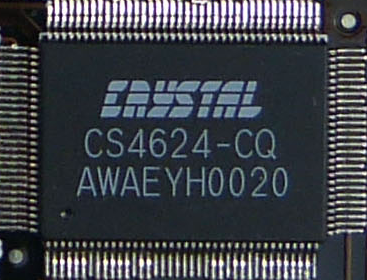FM Synthesis Chips, Codecs and DACs
This article is my attempt to provide some detail around the various primary chips used on PC sound cards, including FM synthesis chips and their associated codecs and DACs
There is a lot more to a sound card that can affect audio quality than just these three, but as the core components, they certainly set the baseline for a sound card's capabilities. There are about 120 different ICs mentioned, including drivers and datasheets where I have managed to find them. In some cases, I have also included the original press release.
For a summary of links to specific chips, here's a table of everything on this page:
FM Synthesis Chips
The FM synthesizer determines the number of independent "voices" that can be output at the same time, as well as the sounds that are played, their duration and effects (attack, sustain, decay, etc). FM synthesizers modulate a waveform to produce a different pitch and timbre (the distinctive sound that makes it different, like the fact a piano sounds different to a guitar). Inside an FM synthesizer are typically a number of "operators". An operator is a group of components that interact with each other to make up a single building block of the FM synthesis setup. Each operator has an input, oscillator, amplifier, and an output. The operator's input sound can be manipulated by feeding in a MIDI input into the oscillator and an envelope generator can be fed into the amplifier portion of the operator to change the timbre that will be output.
In a 2-operator chip, the waveform input coming in is taken through two groups of these (Operator 1 and Operator 2), where the output of the first operator is fed in as the input to the second. This allows the final outgoing waveform to be manipulated twice, further changing what it sounds like. A 4-operator setup has four groups of these (Operator 1, Operator 2, Operator 3 and Operator 4), so the final outgoing waveform (the "voice") is manipulated with up to four different MIDI inputs and envelope generators. You can imagine therefore that a 4-operator FM synth chip can produce a more variable number of unique sounds over a 2-operator chip.
In a typical sound card scenario, the synthesizer chip has a certain number of voices, each of which would have 2 operators or 4 operators. In a stereo scenario the number of available voices is often thought of as being halved (split into left channel and right channel), where each set of two is usually programmed to output the same timbre. This does not change the fact that each voice has its own set of operators, so in theory the left side of the sound can be made to sound completely different from the right.
Audio Codecs
The job of the audio codec ("COder-DECoder") is to encode and decode a digital stream of data or signal, working in conjunction with the DAC (see further down this page). Codecs will often have more than one input line, and sometimes up to 6 stereo inputs (12 lines in total), coming from a microphone, line-in, and so on.
Usually a codec will perform a number of tasks, including conversion of the inbound analog signal to a digital stream of data, filtering it, mixing it with other inputs coming into the codec, then converting it back into an analogue audio signal to be output.
This page has some information on the more common codec chips found on PC sound cards.
DACs
DACs (Digital- to Analog- Converters) are used in almost all sound cards, since the FM synthesizer chip outputs its audio in digital form. The DAC converts these digital I/O signals into analog signals ready for your sound card to mix it or send it straight out to your loudspeakers.
In early FM synthesizer setups during the DOS era, Yamaha's YAC-512 (or a clone of it) was the most common DAC used. From around 1996 when Windows Sound System v1.0 arrived, sound cards tended to use the Analog Devices AD1848 DAC. The later Windows Sound System 2.0 used Crystal CS4231.
Yamaha
|
|||||||||||||||||||||||||||||||||||||||||||||||||||||||||||||||||
|
|||||||||||||||||||||||||||||||||||||||||||||||||||||||||||||||||
|
| OPL3 | OPL3-SA | OPL3-SA2 | OPL3-SA3 | |
|---|---|---|---|---|
| Release Year | 1988 | 1994 | 1995 | 1996 |
| Chips | YMF262, YMF289 | YMF701 | YMF711, YMF718 | YMF715, YMF719 |
| DACs | YAC512, YAC513, YAC516 | Internal | Internal | Internal |
| Plug & Play ISA 1.0a | No | Yes | Yes | Yes |
| 16-bit Address Decoding | No | No | Yes | Yes |
| Hardware Volume Control | No | ? | ? | Yes |
| Power Management | No | No | No | Yes |
| CD-ROM Interface | No | No | Yes | Yes |
| Modem Interface | No | No | Yes | Yes |
| Zoomed Video | No | No | Yes | Yes |
| DAC for OPL4 | No | No | Yes | Yes |
| 3D Audio DSP* | No | No | No | Yes |
The original OPL3-SA was the first to provide ISA Plug & Play compatibility. YMF701 chips are OPL3-SA (1st generation).
OPL3-SA2 added a CD-ROM interface, modem interface, a zoomed video port, and a DAC for OPL4. YMF711 and YMF718 are OPL3-SA2 (2nd generation).
OPL3-SA3 added a "3D sound" digital signal processor. YMF715 and YMF719 are OPL3-SA3 chips (3rd generation).
There are several flavours of YMF719, including YMF719-S, YMF719B-S and YMF719E-S. Windows 2000 and XP support this chipset out of the box, so no external drivers are needed. They are known for their low noise and excellent compatibility. Their MPU-401 interface does not suffer from the "hanging note" bug present in other OPL3 chips. For best quality the internal amp should be disabled via a jumper and all settings in the mixer set to 0 and setting the output type to hi-fi.
Vogons contributor James-F discovered a bug in the YMF71x mixer.
He writes: "
FM = OPL/Wavetable.
WAVE = PCM/Voice.
CD = CD
Line = Line-In
SB = A VERY BUGGY SBPro master volume slider.
Master VOL = Master volume of the card itself (keep at 15). In the process of digging deeper I discovered that the YMF71x mixer has a bug where if SB setting is other than 1 (out of 7) the mixer is non responsive to games and volume changes.
Setting SB to 1 doesn't actually lower any volume of the emulated SBPro but gives the other sliders more range, if it is set to 7 the other sliders do NOTHING and so are games that use the mixer.
Now that the SB volume is set to 1 the YMF717x works just like a normal SBPro and games like Wolfenstein3D and Duke Nukem 3D can control the volume of the mixer like they should."
James-F also worked out the correct way to get the low-pass filter working and sounding just like that
of the Sound Blaster Pro's:
"The lowpass filter DOES exist and it is enabled by default but the SMD cap is so small (250pF) that it has no effect on sound.
I soldered a 100nF cap for the quick test and it was too much and the sound was completely muffled from the right channel, but it proved my theory.
Replace C11 and C19 (left and right) with 6.8nF capacitors, preferably 0805 (2012) 6.8nF SMD Capacitors.
This will make the YMF71x sound similar to the real SBPro which has a functional Lowpass filter, and now the YMF71x has too.
After many capacitors and frequency analysis I found that 6.8nF is the most accurate value and sounded closest to the CT1600 example firage provided, even closer than DOSBox.
So now along with the SB = 1 mixer fix and the modification it makes my Yamaha YMF719 the best DOS card I own."
The YMF719 was the last Yamaha audio chip used on ISA sound cards. From YMF720 onwards they were all PCI-based.
Two such cards that used the YMF718 were the Pine Technology PT2521 and PT2526.
I did a full review of a YMF718/YMF719-based sound card, the Yamaha Audician 32 Plus, in January 2023.
Click here for the YMF715E datasheet (all the above mentioned chips are very similar to this).
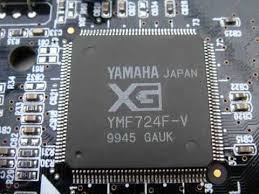 Yamaha YMF720, YMF724
Yamaha YMF720, YMF724 




Released: 1998
Type: FM Synthesizer
Voices: 18 or 22 (FM) + 64 (MIDI)
Operators: 4 per voice
Channels: 1, 2 or 4 (FM), or 1 or 2 (MIDI)
The YMF720 and YMF724 arrived in 1998 and were the successor to the YMF715 and YMF719 OPL3-SA3. Instead of being ISA-based like the OPL3-SAx chips, these were PCI. The YMF724 was the code given to the chip used on standalone PCI cards whereas YMF720 was for embedded systems (integrated directly on the motherboard).
They had an integrated OPL3-SA3 for backward compatibility with Ad Lib, Sound Blaster, Sound Blaster Pro and Windows Sound System, and also have the same MPU-401-compatible interface for external General MIDI synthesizers. In addition, the YMF724 includes a 64-voice GM/DS-XG wavetable synthesizer with 2-channel output, interface to AC'97 codec, S/PDIF output, a Dolby AC-3 decoder, and 3D positional audio via DirectSound3D and QSound.
DOS applications running under Windows 9x and ME could also take advantage of the Yamaha XG tone generator, available via Yamaha's Windows VxD driver.
Most boards with these chips have good quality 18-bit DACs, providing low noise and low harmonic distortion levels.
Click here for the YMF724 datasheet.
It is usually recommended that you use the installation software from your sound card's manufacturer, but in the absence of those, try one of these Yamaha reference drivers:
 Yamaha YMF278, YMF704 (OPL4)
Yamaha YMF278, YMF704 (OPL4) 




Released: 1996
Type: FM Synthesizer
Voices: 24
Operators: 4 per voice
Channels: 1, 2, 4 or 6
The YMF278 chip , also commonly called OPL4, is usually accompanied with a separate 2 MB ROM chip which holds approximately 330 instrument samples that are compatible with the General MIDI standard.
It incorporates both an FM synthesizer and a PCM sample-based synthesizer. The FM synthesizer is essentially a YMF262 (OPL3) so is also backwards-compatible with YM3526 (OPL) and YM3812 (OPL2), but can support 6 channels instead of 4. The PCM sample-based synthesizer supports up to 24 simultaneous voices. It can access up to 4MB of external memory for wave data and a maximum of 512 instrument samples.
Yamaha created the YMF704 in late 1996, which is essentially the same as the YMF278 but with an integrated 1 MB ROM for samples and and MPU-401 interface. The sample ROM contains the same instrument set as the standalone ROM which was certified by Fat Labs.
Sound cards that use the YMF278 include:
Click here for the YMF-704C datasheet.
 Yamaha YMF740, YMF744, YMF754
Yamaha YMF740, YMF744, YMF754 




Introduced: 1999
Type: FM Synthesizer
Voices: 18 or 22 (FM) + 64 (MIDI)
Operators: 4 per voice
Channels: 4
An enhancement over the first of Yamaha's PCI-based chips, YMF720 and 724, the YMF740 and YMF744 provided 4-channel output instead of just 2.
The YMF754 was a low-power version of the YMF744.
Click here for the YMF740C datasheet.
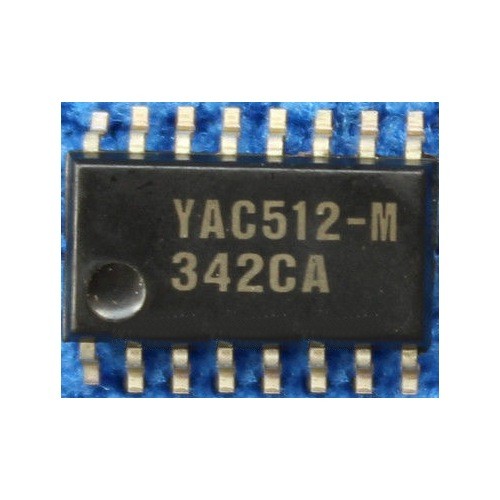 YAC512
YAC512
Introduced: 1988
Type: Digital-to-Analog Converter
Channels: 2
Package: 16-pin SOP
The Yamaha YAC512 was a DAC designed to work alongside the YMF262 or YMF289 FM synthesizer chip.
Click here for the YAC512 datasheet.
 YAC513 / YAC516
YAC513 / YAC516
Introduced: 1988
Type: Digital-to-Analog Converter
Channels: 2
Package: 16-pin DIP or 16-pin SOP
The Yamaha YAC513 was a DAC typically paired to the low-power version of the YMF262, the YMF289.
Click here for the YAC513 and YAC516 datasheets.
ESS Technology
I have a dedicated page for ESS Technology here.
OPTi Inc.
I have a separate page for OPTi, which has possibly more information.
|
|
|
|
|
|
|
Illegitimate Copies and Clones
There also existed some chips which are believed to be full 100% copies of the original Yamaha chips. Some of the more common ones are the LS-212 and LS-215 pair of chips. The LS-212 is a YMF262-M OPL3 copy, while the LS-215 is a YAC512-M DAC equivalent. "215" is "512" backwards (probably not a coincidence!). How do we know these are really copies? The OPTi 82C924 chipset does not include an OPL3-compatible core, yet boards that use this chipset claim to support OPL3, so the chip has to be there somewhere. So the LS-212/LS-215 pair is really the only suspect. Numerous Aztech cards were manufactured using these clones. There also exist less subtle chips blatently marked as LS262 (a copy of the YMF262 OPL3), LS512 (a copy of the YAC512 DAC) and LS245 (a bus trasceiver).
Another set of clones are the DSP24S and DAP16S combination. These chips have been seen on mid-1995 ProComp Pro-Multimedia cards next to an OPTi 82C929A controller. They appear to be straightforward copies of the YMF262-M (DSP24S) and YAC512-M (DAP16S), respectively.
Another copy is the FT6116, a Force Technologies 2Kx8 CMOS SRAM. The FT6116-100 however, is… certainly not. Obviously a cheap Taiwanese sound card has no need for a fast SRAM (static RAM) chip. What’s more, the Avance Logic ALS100 does not include an OPL3 core (unlike its successor, the ALS100+), so an OPL3 chip has to be on the board somewhere. Yes, it's the FT6116-100 chip!
Last on the list is the DXP44Q. This chip appears to be a pin-compatible copy of the Yamaha YMF289B, also known as OPL3-L. This was a low-power chip with power management suitable for portables (and found in the IBM ThinkPad 701C for instance). Once again, the OPTi 82C930A does not include an OPL3 core (unlike its successor, the 82C931). Once again, there has to be an OPL3 on the board somewhere, and the DXP44Q is more or less the only candidate. The 82C930A does include a DAC, which explains the lack of a separate DAC chip.
The fake OPL3 chips are most commonly, but by no means exclusively, found next to an OPTi controller. They have also been seen paired with ESS and Avance Logic controllers, and there’s no reason to think they couldn’t be used with others. The affinity with OPTi controllers could be simply a function of the fact that OPTi had well established and cost-effective controllers available in 1995. ESS and Crystal went relatively quickly from zero to integrating an OPL3 workalike (ESS1688, CS4235), obviating the need for external chips.
Analog Devices / ADI / SoundMax
|
|
|
|
|
|
|
|
|
|
|
|
Realtek / ALC / Avance Logic
All the Realtek and Avance Logic codec chips have the prefix "ALC". Click here for my dedicated Avance Logic page.
Crystal
Cirrus Logic, Inc. produced some of the highest quality audio codecs, mainly used in home theatre receivers. In 1991 they acquired Crystal Semiconductor, a supplier of analog and mixed-signal converter ICs. The Crystal codecs were then marketed as Cirrus Logic's budget line. All these codec chips have the prefix "CS".
|
|
|
|
|
|
|
|
|
|

CS4235 / CS4239
|
|
|
|
|
|
|
Embedded Sound Chips on Motherboards
In the late 1990s, motherboard manufacturers began embedding audio chips, effectively entire sound card technology, on their boards. Whilst these were convenient as PC builders no longer had to install a separate sound card and use up a free expansion slot, the audio quality was often very poor. This section lists the most common of these embedded sound chips.
For C-Media sound drivers, visit their website here.
C-Media ASC-9308
Compatible with Sound Blaster and Sound Blaster Pro. Still named "Compumedia", also gives nearly useless SB16 compatibility.
C-Media CMI8328
Compatible with Sound Blaster and Sound Blaster Pro.
Has an MPU-401 (UART only) interface.
Can be found on the following sound cards:
- AudioExcel AV500 (also has Crystal CS4231A which provides WSS support)
- Zoltrix Audio Plus 3200 AV500
- Zoltrix Audio Plus 3200 V2 AV305
Third-Party DOS Driver (courtesy of Eric Voirin, aka Vogons contributor Oerg866). Go to the GitHub page for source.
C-Media CMI8329A
Not sure of its capabilities, but likely SB and SBPro with MPU-401 as a minimum.
Can be found on the following sound cards:
- Zoltrix Audio Plus AP6400 - has a wavetable and a 3D sound header. The chip is branded "AD Chips", probably to make to appear to be an Analog Devices chip.
C-Media CMI8330
Often found on cheap PC Chips motherboards, these are sometimes branded "HT1869V+ SoundPro". Also found on some ASUS motherboards. Rarely used on sound cards.
Compatible with Sound Blaster, SB Pro, SB16, WSS, and has an MPU-401 (UART only) interface,
OPL3 clone integrated. Even though the chip has "PCI" written on it, it actually uses the ISA bus.
Plug & Play.
S/PDIF input/output.
Rare examples of a sound card with this chip is this one called the Bannsan BS-1 and this one from Elpina - there are other versions of this same Elpina card that are unbranded, but are identical in every other way. The card's DOS compatibility is supposedly very good, though FM output is incredibly quiet (low volume) and the card is susceptible to picking up lots of noise. Another card with the CMI8330 is the Surf Media Surf Sound AD-16 (ACM-9738), which is also branded as the AudioExcel AV310 and Zoltrix Audio Plus 6400 3D PnP. These cards also come with onboard simulated 3D surround sound.
In fact the overall quality of the CMI8330 is downright appalling. In playback tests conducted by PCAVTech, it got a Signal-to-Noise ratio of just -33dB - this is about as poor as they come.
Drivers
It is usually recommended that you use the installation software from your sound card's manufacturer, but in the absence of those, try one of these:
DOS, Windows 3.1,
Windows 95
Windows 95 Driver update DirectX v5.0
Updated Mixer program v1.7A
Driver Update to Fix Windows 98 Problems
C-Media CMI8338
Often found on cheap PC Chips motherboards, although are sometimes branded "HT8338/PCI SoundPro".
C-Media CMI8738
Often found on cheap PC Chips motherboards, although are sometimes branded "HT8738/PCI SoundPro". This was the same as the CMI8338, but included an integrated PCtel 56K PCI fax/modem. It's also found on many cheap PCI sound cards, including the Mercury whose box indicates it supports DirectSound and Aureal A3D surround sound, and the Pine Technology PS-M01A.
Realtek
Realtek embedded sound chips post-date the DOS era, so won't be covered here.
